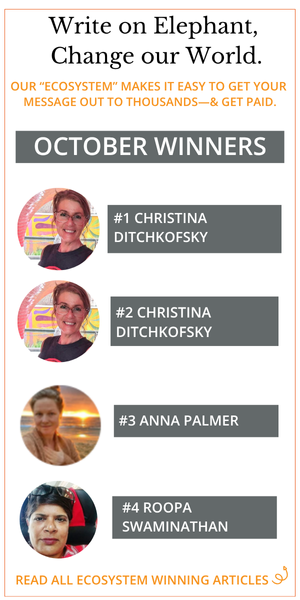*Editor’s Note: Elephant is not your doctor or hospital. Our lawyers would say “this web site is not designed to, and should not be construed to provide medical advice, professional diagnosis, opinion, or treatment to you or any other individual, and is not intended as a substitute for medical or professional care and treatment. Always consult a health professional before trying out new home therapies or changing your diet.” But we can’t afford lawyers, and you knew all that. ~ Ed
As a holistic health coach, I saw the rising star of wellness business and different kinds of home-based “DIY” kind of health care trends.
But it’s also enough to think back of the previous years and how our health became a top priority worldwide. In fact, you don’t need to go as far as COVID-19; the self-care trends are also contributing a lot to making our planet sick. Just think of all the plastic we buy when we get our vitamins or nonessentials like collagen and protein and superfood powders we add to our smoothies. Even necessary things like medication or a simple inhaler are made of plastic, releasing propellant into the air.
The tools we all rely on to stay healthy are making our planet sick. The health care industry alone is responsible for around 5% of global greenhouse gas emissions—and that number is likely closer to 10% in the United States. And this doesn’t include the many products that would classify under beauty industry as well. The fossil fuels burned to create, transport, and administer these health and hygiene products ultimately end up in our atmosphere as air pollution—which is responsible for 7 million premature deaths a year—mostly in low, and middle, income countries.
To move into a healthier future, we’ll have to renovate our health care system as a whole. But everything starts first on an individual level, and until we reach this global change, there are things we can do.
There are many sustainable personal hygiene practices that we can adopt in our life in order to be more environmentally friendly.
1. Choose Sustainable Products
As more and more of us are looking for products that are sustainable—not only for us but for the planet as well—the more companies started to prioritize sustainable production and introduce products to the market with more sustainable or recycled packaging, like baby diapers and femcare products. Around 53% of consumers focus on low-carbon footprint when selecting a brand, and millennial parents are willing to pay for the sustainably sourced and produced diaper (Euromonitor International Health & Nutrition Survey, 2020).
2. Opt for Zero-Waste and Eco-Friendly Options
Wooden toothbrushes are more sustainable, as they’re biodegradable and don’t damage the environment. Thought bamboo is better than plastic, but as most of the bamboo forests are in China, more likely there will be emissions associated with it. You can also find sustainable shampoo and conditioner bars that last long and don’t come in single-use plastic containers. There are brands that use recycled material for their packaging (protein powders, vitamins, and other supplements). Make sure you research them well before you purchase.
3. Switch to reusable options
This one probably saves a lot of money for you as well. I can’t even count how much money I saved by switching to a silicone lady cup instead of buying pads and tampons. If you don’t like that idea, you can choose washable pads as well. There are washable versions of baby diapers too, which are easy to handle (as I experienced through my friends; they all love it). Instead of cottons balls, there are washable facial wipes as well. You can basically find a reusable version for anything now. Another sustainable personal hygiene option is to purchase a safety razor.
4. Make your own products
If you prefer DIY or are not able to invest in these options, you can still make your own. I like to mold leftover soaps into a new, bigger one. But making your own cleanser products, toothpaste, deodorant, exfoliator, face or hair mask, and conditioner is super easy too.
5. Natural medicine as prevention
I guess everyone wins if you take care of your health before it gets so bad that you need to seek the attention of a doctor. With natural preventions, you can support your immune system and will be more likely to not catch illnesses. There are many ways to support your health and prevent getting sick by consuming foods like garlic, ginger, herbal teas, and herbal supplements and making sure you get the right amount of minerals and vitamins.
6. Shop from zero-waste stores
Zero-waste stores are a great place to find sustainable personal hygiene and health care products.
7. Minimising products and consumption
An evident step to follow now we mentioned stores. Do you really use and need all the things in your bathroom? Do you really need all the health care items you keep for, well, just in case? Do you really need to buy that protein powder that comes in a huge plastic container that is 60% empty anyways? Or could you minimize these and opt for other choices? You could increase your protein intake by eating more protein packed foods. My trick is to add silken tofu to my smoothies. Relying on less external items will create more space internally.
I hope these tips have helped you identify some areas where you can let your sustainable side expand in your personal hygiene and health care routine. Remember that making these long-lasting changes can be a long process and a journey, but even by one action at a time you are making a positive impact to minimize your footprint on the planet.
If we all collectively commit to these small shifts and changes, eventually we will see big results and a global change in our behaviour for the better.
~
Please consider Boosting our authors’ articles in their first week to help them win Elephant’s Ecosystem so they can get paid and write more.


 Share on bsky
Share on bsky





Read 1 comment and reply